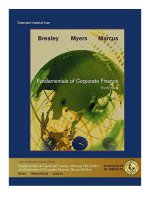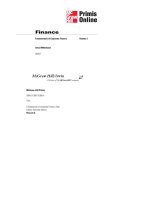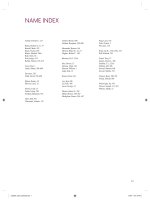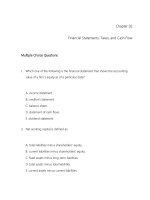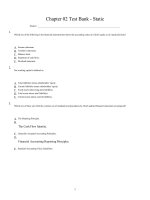Lecture Fundamentals of corporate finance: Lecture 14 - Ross, Westerfield, Jordan
Bạn đang xem bản rút gọn của tài liệu. Xem và tải ngay bản đầy đủ của tài liệu tại đây (1.02 MB, 23 trang )
Chapter
Fourteen
Options and
Corporate Finance
© 2003 The McGrawHill Companies, Inc. All rights reserved.
14.2
Key Concepts and Skills
• Understand the options terminology
• Be able to determine option payoffs and pricing
bounds
• Understand the five major determinants of option
value
• Understand employee stock options
• Understand the various managerial options
• Understand the differences between warrants and
traditional call options
• Understand convertible securities and how to
determine their value
McGrawHill/Irwin
© 2003 The McGrawHill Companies, Inc. All rights reserved.
14.3
Chapter Outline
•
•
•
•
•
•
•
Options: The Basics
Fundamentals of Option Valuation
Valuing a Call Option
Employee Stock Options
Equity as a Call Option on the Firm’s Assets
Options and Capital Budgeting
Options and Corporate Securities
McGrawHill/Irwin
© 2003 The McGrawHill Companies, Inc. All rights reserved.
14.4
Option Terminology
•
•
•
•
•
•
•
•
Call
Put
Strike or Exercise price
Expiration date
Option premium
Option writer
American Option
European Option
McGrawHill/Irwin
© 2003 The McGrawHill Companies, Inc. All rights reserved.
14.5
Option Payoffs – Calls
• The value of the call at
expiration is the
intrinsic value
• Assume that the
exercise price is $35
20
Call Value
– Max(0, SE)
– If S
– If S>E, then the payoff
is S – E
Call Option Payoff
Diagram
15
10
5
0
0 10 20 30 40 50 60
Stock Price
McGrawHill/Irwin
© 2003 The McGrawHill Companies, Inc. All rights reserved.
14.6
Option Payoffs - Puts
• The value of a put at
expiration is the
intrinsic value
• Assume that the
exercise price is $35
40
Option Value
– Max(0, ES)
– If S
– If S>E, then the payoff
is 0
Payoff Diagram for Put
Options
30
20
10
0
0 10 20 30 40 50 60
Stock Price
McGrawHill/Irwin
© 2003 The McGrawHill Companies, Inc. All rights reserved.
14.7
Call Option Bounds
• Upper bound
– Call price must be less than or equal to the stock price
• Lower bound
– Call price must be greater than or equal to the stock price
minus the exercise price or zero, whichever is greater
• If either of these bounds are violated, there is an
arbitrage opportunity
McGrawHill/Irwin
© 2003 The McGrawHill Companies, Inc. All rights reserved.
14.8
Figure 14.2
McGrawHill/Irwin
© 2003 The McGrawHill Companies, Inc. All rights reserved.
14.9
A Simple Model
• An option is “inthemoney” if the payoff is
greater than zero
• If a call option is sure to finish inthemoney,
the option value would be
– C0 = S0 – PV(E)
• If the call is worth something other than this,
then there is an arbitrage opportunity
McGrawHill/Irwin
© 2003 The McGrawHill Companies, Inc. All rights reserved.
14.10
What Determines Option Values?
• Stock price
– As the stock price increases, the call price increases and
the put price decreases
• Exercise price
– As the exercise price increases, the call price decreases and
the put price increases
• Time to expiration
– Generally, as the time to expiration increases both the call
and the put prices increase
• Riskfree rate
– As the riskfree rate increases, the call price increases and
the put price decreases
McGrawHill/Irwin
© 2003 The McGrawHill Companies, Inc. All rights reserved.
14.11
What about Variance?
• When an option may finish outofthemoney (expire
without being exercised), there is another factor that
helps determine price
• The variance in underlying asset returns is a less
obvious, but important, determinant of option values
• The greater the variance, the more the call and the put
are worth
– If an option finishes outofthemoney, the most you can
lose is your premium, no matter how far out it is
– The more an option is inthemoney, the greater the gain
– You gain from volatility on the upside, but don’t lose
anymore from volatility on the downside
McGrawHill/Irwin
© 2003 The McGrawHill Companies, Inc. All rights reserved.
14.12
Table 14.2
McGrawHill/Irwin
© 2003 The McGrawHill Companies, Inc. All rights reserved.
14.13
Employee Stock Options
• Options that are given to employees as part of their
benefits package
• Often used as a bonus or incentive
– Designed to align employee interests with stockholder
interests and reduce agency problems
– Empirical evidence suggests that they don’t work as well
as anticipated due to the lack of diversification introduced
into the employees’ portfolios
– The stock just isn’t worth as much to the employee as it is
to an outside investor
McGrawHill/Irwin
© 2003 The McGrawHill Companies, Inc. All rights reserved.
14.14
Equity: A Call Option
• Equity can be viewed as a call option on the
company’s assets when the firm is leveraged
• The exercise price is the value of the debt
• If the assets are worth more than the debt when it
comes due, the option will be exercised and the
stockholders retain ownership
• If the assets are worth less than the debt, the
stockholders will let the option expire and the assets
will belong to the bondholders
McGrawHill/Irwin
© 2003 The McGrawHill Companies, Inc. All rights reserved.
14.15
Capital Budgeting Options
• Almost all capital budgeting scenarios contain
implicit options
• Because options are valuable, they make the
capital budgeting project worth more than it
may appear
• Failure to account for these options can cause
firms to reject good projects
McGrawHill/Irwin
© 2003 The McGrawHill Companies, Inc. All rights reserved.
14.16
Timing Options
• We normally assume that a project must be taken
today or foregone completely
• Almost all projects have the embedded option to wait
– A good project may be worth more if we wait
– A seemly bad project may actually have a positive NPV if
we wait due to changing economic conditions
• We should examine the NPV of taking an investment
now, or in future years, and plan to invest at the time
that produces the highest NPV
McGrawHill/Irwin
© 2003 The McGrawHill Companies, Inc. All rights reserved.
14.17
Example: Timing Options
• Consider a project that costs $5000 and has an
expected future cash flow of $700 per year forever. If
we wait one year, the cost will increase to $5500 and
the expected future cash flow increase to $800. If the
required return is 13%, should we accept the project?
If so, when should we begin?
– NPV starting today = 5000 + 700/.13 = 384.16
– NPV waiting one year = (5500 + 800/.13)/(1.13) = 578.62
– It is a good project either way, but we should wait until
next year
McGrawHill/Irwin
© 2003 The McGrawHill Companies, Inc. All rights reserved.
14.18
Managerial Options
• Managers often have options after a project has been
implemented that can add value
• It is important to do some contingency planning
ahead of time to determine what will cause the
options to be exercised
• Some examples include
– The option to expand a project if it goes well
– The option to abandon a project if it goes poorly
– The option to suspend or contract operations particularly in
the manufacturing industries
– Strategic options – look at how taking this project opens up
other opportunities that would be otherwise unavailable
McGrawHill/Irwin
© 2003 The McGrawHill Companies, Inc. All rights reserved.
14.19
Warrants
• A call option issued by corporations in conjunction
with other securities to reduce the yield
• Differences between warrants and traditional call
options
– Warrants are generally very long term
– They are written by the company and exercise results in
additional shares outstanding
– The exercise price is paid to the company and generates
cash for the firm
– Warrants can be detached from the original securities and
sold separately
McGrawHill/Irwin
© 2003 The McGrawHill Companies, Inc. All rights reserved.
14.20
Convertibles
• Convertible bonds (or preferred stock) may be
converted into a specified number of common shares
at the option of the bondholder
• The conversion price is the effective price paid for
the stock
• The conversion ratio is the number of shares received
when the bond is converted
• Convertible bonds will be worth at least as much as
the straight bond value or the conversion value,
whichever is greater
McGrawHill/Irwin
© 2003 The McGrawHill Companies, Inc. All rights reserved.
14.21
Valuing Convertibles
• Suppose you have a 10% bond that pays semiannual
coupons and will mature in 15 years. The face value
is $1000 and the yield to maturity on similar bonds is
9%. The bond is also convertible with a conversion
price of $100. The stock is currently selling for $110.
What is the minimum price of the bond?
–
–
–
–
Straight bond value = 1081.44
Conversion ratio = 1000/100 = 10
Conversion value = 10*110 = 1100
Minimum price = $1100
McGrawHill/Irwin
© 2003 The McGrawHill Companies, Inc. All rights reserved.
14.22
Other Options
• Call provision on a bond
– Allows the company to repurchase the bond prior to
maturity at a specified price that is generally higher than
the face value
– Increases the required yield on the bond – this is
effectively how the company pays for the option
• Put bond
– Allows the bondholder to require the company to
repurchase the bond prior to maturity at a fixed price
• Insurance and Loan Guarantees
– These are essentially put options
McGrawHill/Irwin
© 2003 The McGrawHill Companies, Inc. All rights reserved.
14.23
Quick Quiz
• What is the difference between a call option and a put
option?
• What is the intrinsic value of call and put options and
what do the payoff diagrams look like?
• What are the five major determinants of option prices
and their relationships to option prices?
• What are some of the major capital budgeting
options?
• How would you value a convertible bond?
McGrawHill/Irwin
© 2003 The McGrawHill Companies, Inc. All rights reserved.
